Related Research Articles

Woollarawarre Bennelong(also: "Baneelon") was a senior man of the Eora, an Aboriginal Koori people of the Port Jackson area, at the time of the first British settlement in Australia, in 1788. Bennelong served as an interlocutor between the Eora and the British, both in Sydney and in the United Kingdom.

The Aboriginal Tasmanians are the Aboriginal people of the Australian state of Tasmania, located south of the mainland. For much of the 20th century, the Tasmanian Aboriginal people were widely, and erroneously, thought of as being an extinct cultural and ethnic group that had been intentionally exterminated by white settlers. Contemporary figures (2016) for the number of people of Tasmanian Aboriginal descent vary according to the criteria used to determine this identity, ranging from 6,000 to over 23,000.
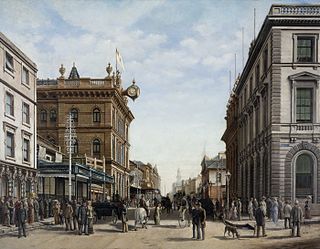
The History of Sydney begins in prehistoric times with the occupation of the district by Australian Aboriginals, whose ancestors came to Sydney in the Upper Paleolithic period. The modern history of the city began with the arrival of a First Fleet of British ships in 1788 and the foundation of a penal colony by Great Britain.

Greensborough is a suburb of Melbourne, Victoria, Australia, 17 km (11 mi) north-east from Melbourne's Central Business District. Its local government areas are the City of Banyule and the Shire of Nillumbik. At the 2016 Census, Greensborough had a population of 20,821.

The Darug or Dharug people are an Aboriginal Australian people, who share strong ties of kinship and, in pre-colonial times, survived as skilled hunters in family groups or clans, scattered throughout much of what is modern-day Sydney.

The Eora (Yura) are an Aboriginal Australian people of New South Wales. Eora is the name given by the earliest settlers to a group of Aboriginal people belonging to the clans along the coastal area of what is now known as the Sydney basin, in New South Wales, Australia. The Eora share a language with the Darug people, whose traditional lands lie further inland, to the west of the Eora.

Laura is a small town and locality in Cook Shire, Cape York Peninsula in northern Queensland, Australia. It is on the only road north towards the tip of the peninsula, and is the centre for the largest collection of prehistoric rock art in the world. It also forms the northern apex of the "Scenic Triangle" between Cooktown, Lakeland, and Laura.

Pemulwuy was an Aboriginal Australian of Eora descent, born around 1750 in the area of Botany Bay in New South Wales. He is noted for his resistance to the European settlement of Australia which began with the arrival of the First Fleet in January 1788. He is believed to have been a member of the Bidjigal (Bediagal) clan of the Eora people. The Bidjigal people are the original inhabitants of Toongabbie and Parramatta in Sydney.

The Cammeraygal, variously spelled as Cam-mer-ray-gal, Gamaraigal, Kameraigal, Cameragal and several other variations, were a clan of the Eora tribe of Indigenous Australians who were united by a common language, strong ties of kinship and survived as skilled hunter–fisher–gatherers in family groups or clans that inhabited the Lower North Shore of Sydney, New South Wales, Australia.
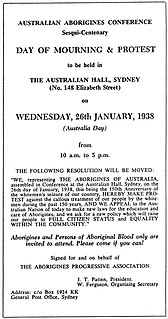
The Day of Mourning was a protest held by Aboriginal Australians on 26 January 1938, the 150th anniversary of the British colonisation of Australia. It was declared to be a protest of 150 years of callous treatment and the seizure of land and purposefully coincided with the Australia Day celebrations held by the European population on the same day. The protest became a tradition, and annual Days of Mourning have been held to this day.
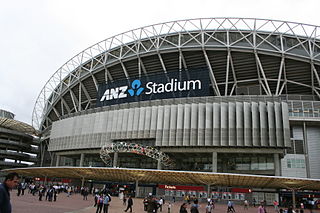
Sydney Olympic Park is a suburb of Greater Western Sydney, located 13 kilometres west of the Sydney central business district, in the local government area of the City of Parramatta Council. It is commonly known as Olympic Park but officially named Sydney Olympic Park. The area was originally part of the suburb of Homebush Bay, but was designated a suburb in its own right in 2009. The name Homebush is still used colloquially as a metonym for Stadium Australia as well as the Olympic Park precinct as a whole.
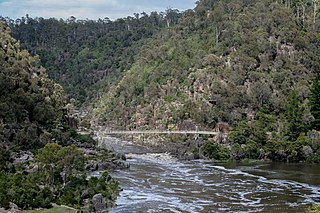
The South Esk River, the longest river in Tasmania, is a major perennial river located in the northern region of Tasmania, Australia.

Evandale is a historic town in northern Tasmania, Australia. It sits on the banks of the South Esk River, 18 km south of Launceston. The town is famous for its late-Georgian and early-Victorian buildings with relatively untouched streetscape, a popular Sunday market and as a host to the annual World Penny Farthing bicycle Championships. At the 2016 census, Evandale had a population of 1,345.
The Cadigal, also spelled as Gadigal and Caddiegal, are a group of indigenous Australians whose traditional lands are located in Sydney, New South Wales, Australia. The Cadigal originally inhabited the area that they called "Cadi" that lies south of Port Jackson covering today's Sydney central business district and stretches from South Head to Petersham with part of the southern boundary lying on the Cooks River.

The Dharawal, or Tharawal, people are Indigenous Australians, those Australian Aboriginal people who are united by the Dharawal language, and strong ties of kinship. They lived as skilled hunter–fisher–gatherers in family groups or clans scattered along the coastal area of what is now known as the Sydney basin, in New South Wales.

The Aborigines Progressive Association (APA) was established in 1937 by William Ferguson and Jack Patten in Dubbo, New South Wales. Ferguson led a group in the western part of the state, while Patten assembled an alliance of activists in the north-east. Both wings of the APA were involved in political organisation, rallies, and protests in both Aboriginal communities and reserves and major NSW centres such as Sydney.
The Bidjigal people are an Aboriginal Australian people whose traditional lands are modern-day western, north-western, south-eastern, and southern Sydney, in New South Wales, Australia.

Australia Day is the official national day of Australia. Observed annually on 26 January, it marks the 1788 raising of the British flag at Sydney Cove by Arthur Phillip following days of exploration of Port Jackson in New South Wales by the First Fleet. In present-day Australia, celebrations aim to reflect the diverse society and landscape of the nation and are marked by community and family events, reflections on Australian history, official community awards and citizenship ceremonies welcoming new members of the Australian community.
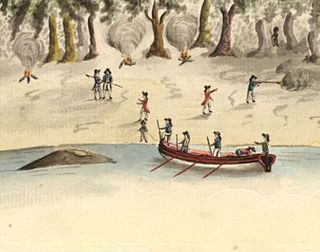
The Hawkesbury and Nepean Wars (1794–1816) were a series of conflicts where British forces, including armed settlers and detachments of the British Army in Australia, fought against Indigenous clans inhabiting the Hawkesbury River region and the surrounding areas to the west of Sydney. The wars began in 1794, when the British started to construct farms along the river, some of which were established by soldiers.
References
- 1 2 "North Coastal: Before Cook". A History of Aboriginal Sydney. Western Sydney University. Retrieved 25 December 2016.
- ↑ "History". Crows Nest Mainstreet. Retrieved 25 December 2016.
- ↑ "Eora: Mapping Aboriginal Sydney 1770-1850" (PDF). State Library of NSW. 2006. p. 10. Retrieved 25 December 2016.
| | This Indigenous Australians-related article is a stub. You can help Wikipedia by expanding it. |